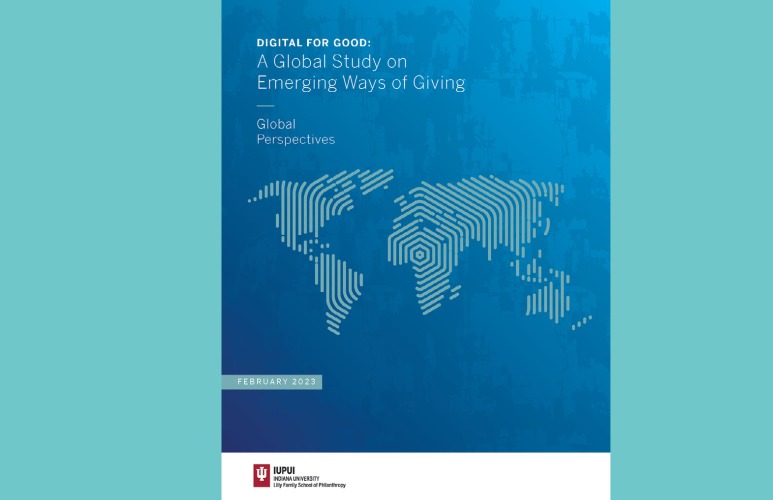Digital funding is taking root across the globe, with donors embracing a variety of donation mechanisms appropriate to the infrastructure in their nations, cultural norms and speed with which they adopt new channels.
That’s part of a new report, Digital for Good: A Global Study on Emerging Ways of Giving from Indiana University’s Lilly Family School of Philanthropy.
The report presents funding technique innovation and adoption within eight countries: Brazil, China, India, Kenya, Singapore, South Africa, South Korea, and the United Kingdom. While regional differences come into play, philanthropy leaders in countries where there are well-established traditions in a given funding form might benefit from seeing how other regions implement them.
“A lot of the forms we see in these countries have been long established. They know things but may also be open to re-schooling or re-imagining,” Una Osili, associate dean for research and international programs at the Lilly Family School of Philanthropy at Indiana University, told The NonProfit Times.
“Workplace giving has existed for a long time, but with remote workplaces, with worker turnover, with the great resignation, there’s a lot of interest in how we re-imagine the workplace of the future,” Osili continued. “In Kenya, workplace giving is taking off, but it’s using [new] technology. From the beginning it is introducing virtual volunteering and matching gifts. There’s an opportunity to learn across borders, and see what’s working, why it is taking off.”
There are some high-level, widespread if not universal, findings. For instance:
* Use of impact investment varies widely from country to country, with the United Kingdom and India being among the top supporters of this method. Within India, initiatives to boost financial inclusion have raised the equivalent of more than (U.S.) $7.3 billion, with investments impacting around 100 million low-income individuals. Donors in China are also developing a strong tradition of impact investing, with 19 foundations having funded more than 2,100 projects initiated by nonprofits and social enterprises.
* Cryptocurrency donations have become more popular in South African and South Korea, while in China, India and Singapore cryptocurrency donations face high regulatory hurdles.
* Donor-advised fund use, which allow funders to irrevocably contribute funds to accounts that will later be distributed to nonprofits, is booming in Singapore and steadily advancing in China, South Africa, South Korea and the United Kingdom.
Technology changes quickly, and the report is not immune to modifications, or even reversals, of its outlook. For example, it is bullish on cryptocurrency. “Last year, cryptocurrency markets were doing quite well,” Osili said. “Many nonprofits were trying to experiment with how they might engage donors, cryptocurrency donations. If you look at the picture today it is quite bleak around cryptocurrency. One cautionary note with many of these newer forms of giving, especially untested options, is for many organizations, donors, funders to realize that some innovation does require risk, but that there are ways of mitigating the risks.”
The eight countries featured were chosen as regional representative samples from a larger list of 91 countries observed by Indiana University’s Global Philanthropy Indicies. While not every country discussed participates in each funding technique, funding options discussed include crowdfunding, cryptocurrency, donor-advised funds, impact investing, mobile giving, social impact investing and workplace giving, among others.
Individual countries embraced myriad fundraising techniques at different rates. For example:
* In Brazil, leaders of the Arredondar Project sought to incorporate retail giving into everyday activities by forming partnerships with a wide swath of retail stores. Separately, sales of editorial products such as books, calendars and publications flourished, and BSocial, a donation platform that enables crowdfunding and donor support of civil society organizations, was launched in 2018.
* A survey experiment in China revealed several factors influencing an online crowdfunding campaign that reflected the country’s emphasis on the population as a whole over the individual: awareness of other donors resulted in a lower amount of donations; messaging that reflected how donating benefitted the individual funder did not raise more money than messaging that emphasized benefits to others; and, funders tended to pull back when informed of a 10% “overhead cost,” as opposed to solicitations that assured donors all of their donation would be used for mission-related functions.
* Donors in India are moving toward online and digital channels, with 70% indicating these are their preferred giving channels. Just fewer than half (45%) are infrequent donors, giving only on special days or during events. Among generational cohorts, the highest indicating they make regular donations are Baby Boomers (people born roughly between 1946 and 1964). Only 29% of those make regular donations. And 47% report “donation fatigue” due to increased need stemming from Covid-19 related issues.
* Crowdfunding is expanding substantially in Kenya, making fundraising easier for nonprofits there. But efforts to increase the effectiveness of crowdfunding are hampered by the need for increased accountability, flexible regulation, and greater campaign creativity. Employees in Kenyan organizations report a stronger culture of giving and heightened sense of community if their employers allow workplace giving campaigns.
* The COVID-19 crisis boosted individual digital donations in Singapore, with online donations increasing 37% and online volunteering jumping 29% between mid-2020 and early 2021. In-kind donations, which are relatively new to the Singapore funder community, also increased during that period, with more than 70% of individual donors making in-kind contributions, and more than 53% purchasing goods and services from nonprofits.
* Crowdfunding boomed during the COVID-19 pandemic in South Africa, as did retail giving and mobile giving, although the latter two channels waned as lockdown restrictions were rolled back.
* The acceleration of contactless giving (non-face-to-face funding) was especially evident in South Korea, where giving though automatic response system (telephonic-enabled giving), general interbank recurring order (donations made directly from a funder’s bank account) and peer-to-peer donation use increased during the pandemic. During that time, revenue from crowdfunding jumped by 71%, from the equivalent of (U.S.) $18.8 million in 2019 to (U.S.) $30.8 million in 2020. This is in part because South Korea is leading the way in terms of fandom donations, in which admirers of celebrities fund nonprofits as a show of community influence and support.
* Funders in the United Kingdom continue to embrace hybrid giving structures in which online and offline communication both play a role in philanthropic activity. The trend toward online giving should increase, as younger philanthropists are more likely to donate online than their older cohorts.
There was at least one universal finding. “When we talk about philanthropy, one of the points we make, especially in this global environment, is that generosity is widespread in every culture,” Osili said. “One of the strongest findings is that pretty much every community, every region, every collective, has some tradition of generosity, but how it is manifested varies across countries.”
A full copy of the report is available here: https://globalindices.iupui.edu/additional-research/digital-for-good/index.html










